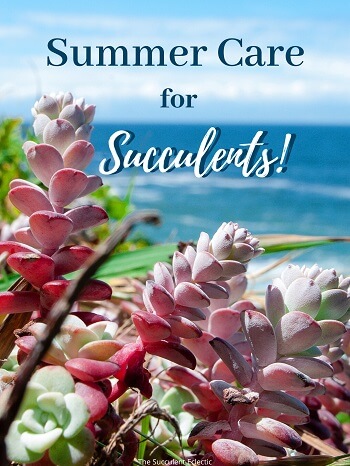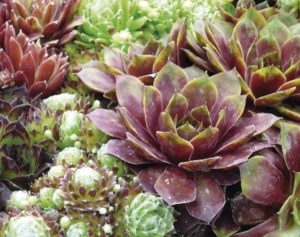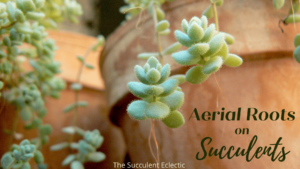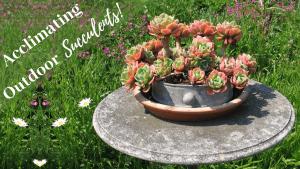We all love summer, but it’s a challenging time in the garden. The increased heat and UV radiation is a source of stress and potential damage for your plants. Succulents have a number of adaptations for surviving summer. It’s important that you don’t mistake those adaptations for problems you need to fix. But also, don’t assume the plants have everything covered. Just as you take extra care with small children and pets to protect them from sunburn and heatstroke, your succulents need special care in order to thrive in the hot, drying days of summer. Read on to learn all the specifics of succulent care in summer.
Summer Care for Succulents
In this Post We'll Cover:
- Summer Care for Succulents
- How Succulents Respond to Summer
- Shade Cloth Protects Succulents from Sunburn
- How to Water Succulents in Summer
- Caring for Summer Dormant Succulents
- Summer Care for Mixed Succulents
- To Groom or Not to Groom?
- Summer Pests and Succulents
- Conserve Water and Repel Pests with Top Dressing
- Adding New Succulents in Summer
{Please note, some links in this post may be affiliate links to sites that pay me a small commission if you click on the link and make a purchase. This commission is at absolutely no cost to you. I only recommend products and companies that I have worked with and truly love! ~Kat}
Summer care for succulents includes a number of facets, starting with protecting your plants from sunburn. Just because your succulents can take full sun in spring is no guarantee they won’t fry in the same location come summer. Summer care also includes adjusting how and when you water, learning to recognize signs of dormancy, preventing pest damage, taking care with new purchases and providing top dressings.
How Succulents Respond to Summer
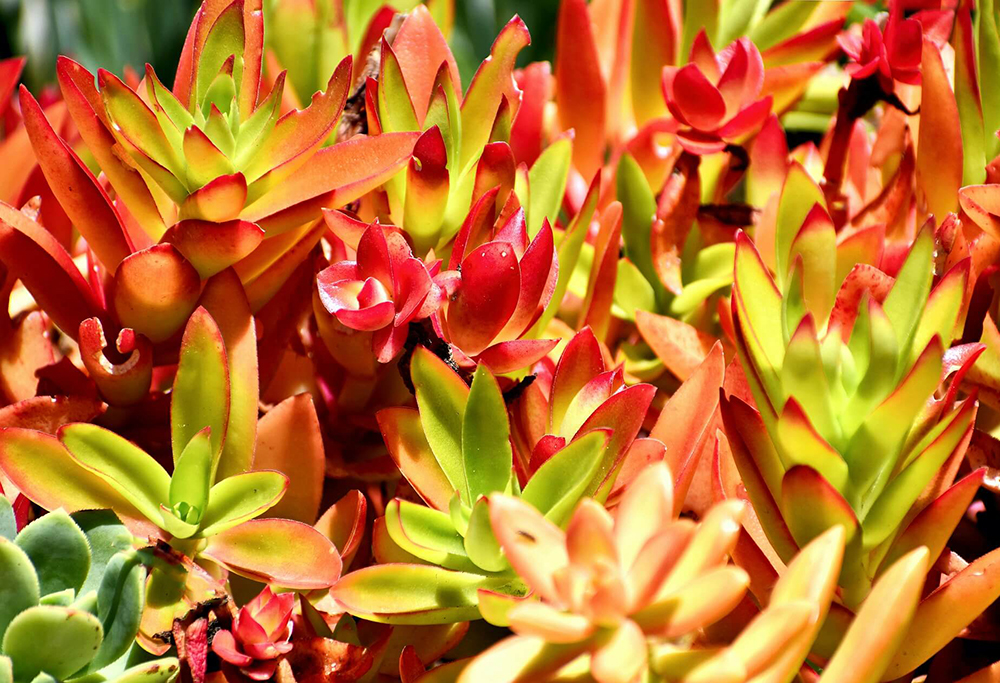
Some succulents, like the Crassula capitella ‘Campfire’ above, respond to the added heat and intensity of summer sunlight with a glorious display of color. They develop brightly colored pigments to protect their succulent leaves from burning. But some succulents have evolved a number of other protections against the searing heat of summer. Some succulents even go dormant during the hottest months. Others cover themselves in a protective sunscreen called epicuticular wax. Still others have developed a special form of photosynthesisPhotosynthesis (FO-to-SIN-thuh-sis) is the process plants us... More that allows them to conserve their moisture during the heat of the day, opening the stomata of their leaves for respirationRespiration is the process where living beings, both animals... More only at night. This may leave them looking a bit wilted during the day, but they plump and firm back up in the evening.
These adaptations can be confusing. Alert succulent-growers may be alarmed at a dramatic change in color. Others will interpret the dropped leaves and slowed response of dormancy as an indication the plant is dying. Tragically, most respond by giving their succulent more water which can cause death, especially while the plant is dormant.
It’s important to understand how your succulents may change in response to the challenges of summer. Read my blog post about 9 succulent adaptations to summer. Then, let’s see how to adjust your succulent care in summer.
Shade Cloth Protects Succulents from Sunburn
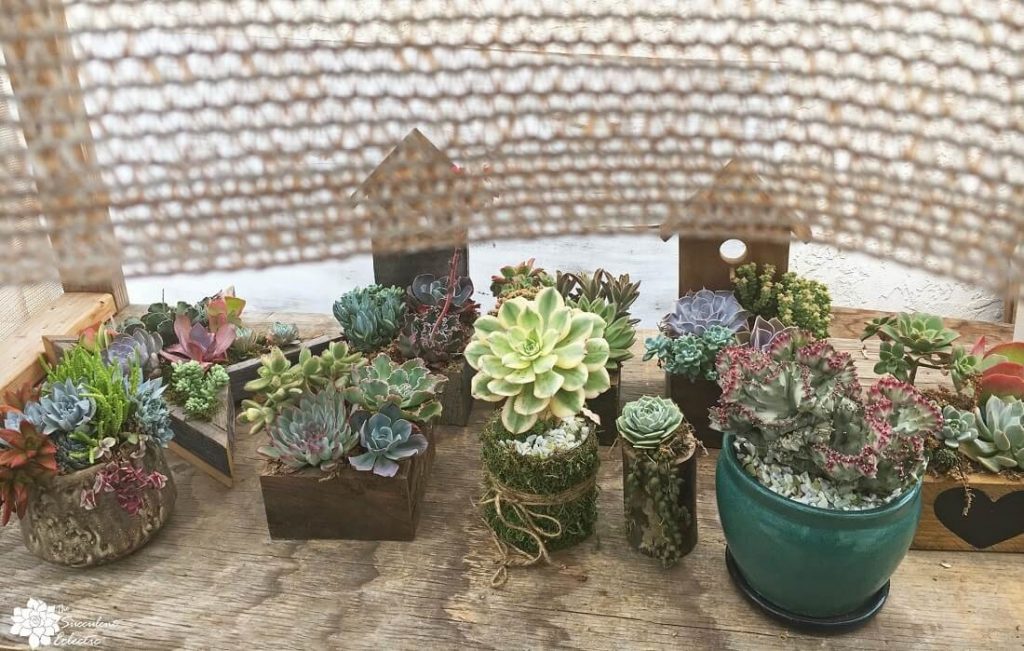
Many succulents that thrive in full sun fall through spring will suffer or even collapse in the full sun of summer. The UV radiation of the sun is greatest in summer. Increased radiation together with higher temperatures make summer sun exposure much more damaging for people and plants alike. Summer care for succulents may include moving some potted plants to partial shade, or rigging a shade structure to provide protection.
Succulent sunburn is not just unsightly, it can be deadly. Burned leaves are permanently scarred and will never recover. The scarred leaf tissues cannot photosynthesize, so the plant cannot use it to turn sunlight into energy. If the plant has enough undamaged leaves, eventually it can outgrow the scars of sunburn. But when more than 50% of the plant is burned, it can struggle to survive.
Using shade cloth is an essential part of succulent care in summer. It’s a great way to give your plants the abundant light they need while shielding them from the intense UV radiation and heat of high summer. Shade cloth protects plants from sun damage while permitting some light to filter through. You can find shade cloth in a variety of colors and rated to block from 5% to 90% of UV rays. Don’t confuse the colors with the density of shade cast. For growing succulents, you’ll want something that provides 35% – 70% shade, depending upon your climate. The hotter and fiercer your summers are, the higher the percentage of shade you should choose.
How to Water Succulents in Summer
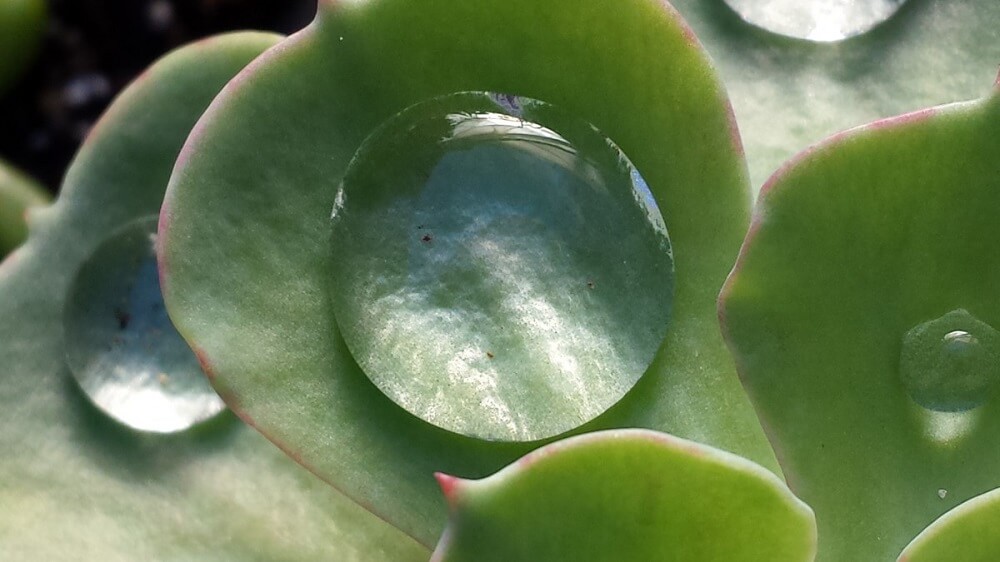
Summer care for succulents requires that you take extra care when you water your succulents in summer. You should still only water succulents when the soil is dry. But in summer, pay attention to when you water and how. Garden hoses and watering cans can become very hot in the middle of the day. Be careful not to dump scalding hot water on your plants!
Also, make note of how quickly your plants make us of the water in the soil. If the plants go through water more quickly in summer, that makes sense. Actively growing plants may need more water to supplement that lost due to increased evaporation and transpirationTranspiration is the process of water movement through plant... More.
But some succulents go dormant in summer and don’t need to be watered. In fact, dormant plants should be allowed to remain dry. So how does this affect succulent care in summer?
Caring for Summer Dormant Succulents
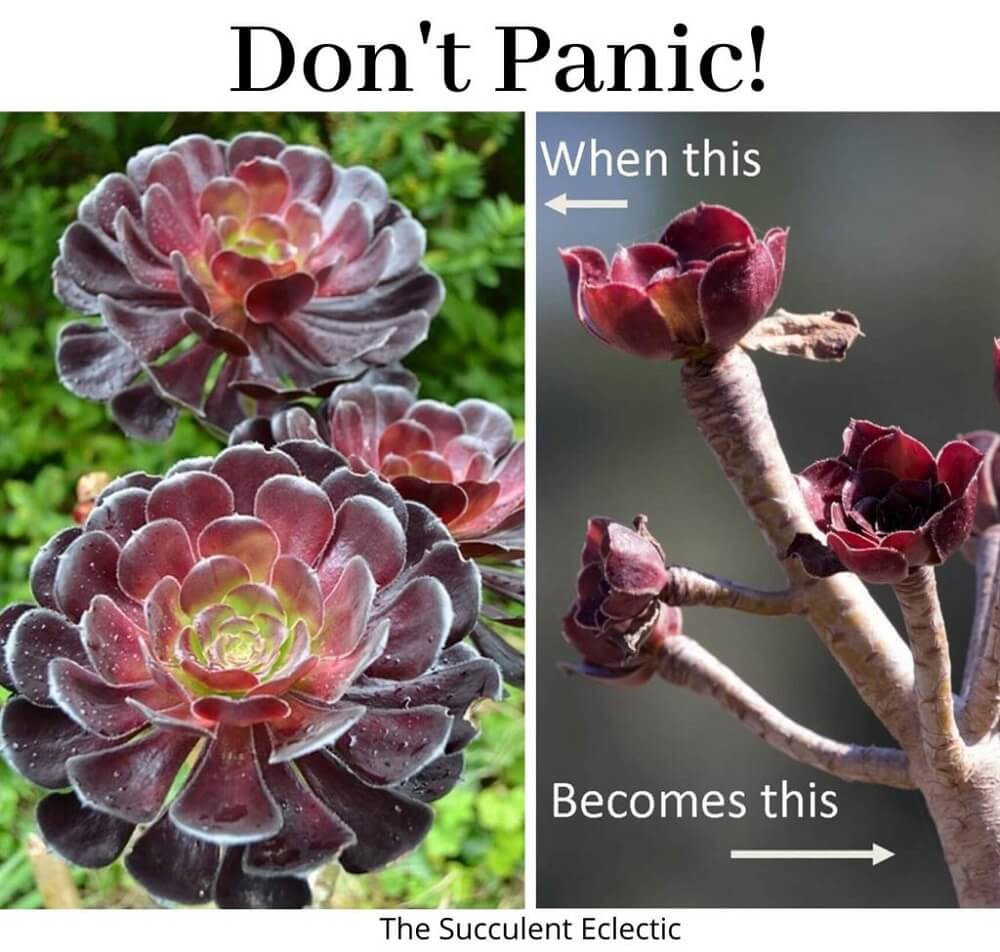
Some succulents respond to searing summer heat and lack of summer rain in their native habitat by going dormant. They largely shut down their biological processes, taking in very little water, essentially sleeping through the harsh season. Understanding dormancy is an important part of summer care for succulents. When succulents go dormant, some are pretty obvious. Aeonium arboreum, above, can be quite dramatic. It may drop its leaves and really worry a succulent-lover. But many summer-dormant succulents don’t look much different than the rest of the year. They retain their foliage and simply stop. They stop growing, they slow their drinking so much that it seems to stop. Succulent care in summer relies on patient observation of small changes.
What makes this question even trickier is that most succulents that go dormant in summer do so only when they need to. They are considered “opportunistic” in their dormancy, meaning they can “choose” to go dormant if the conditions warrant it. So, although I have compiled a list for you of summer dormant succulents, I don’t recommend you worry about memorizing it. Instead, know that some succulents do go dormant in summer, and others in winter. Then, pay close attention to your plants, and when you notice something seems off, and you’ve ruled out obvious causes, check the season and my succulent dormancy table. Dormancy may explain the odd conditions that concerned you.
When you know you have a dormant succulent, stop watering. It is not awake and actively using the water. The plants go dormant in summer because their native habitat gets no rain during the season. They have adapted to being dry all summer long. If you have succulents that seem to collapse in summer (Aeonium and Sempervivum — I’m looking at you!) you can move them into shade and leave them dry until the cooler temps of fall arrive. The plants will draw upon the water stored in their leaves, stems and roots for what little they need while dormant. You’ll know a dormant plant is waking up and needs more water when you see either wrinkled foliage or new growth!
Summer Care for Mixed Succulents
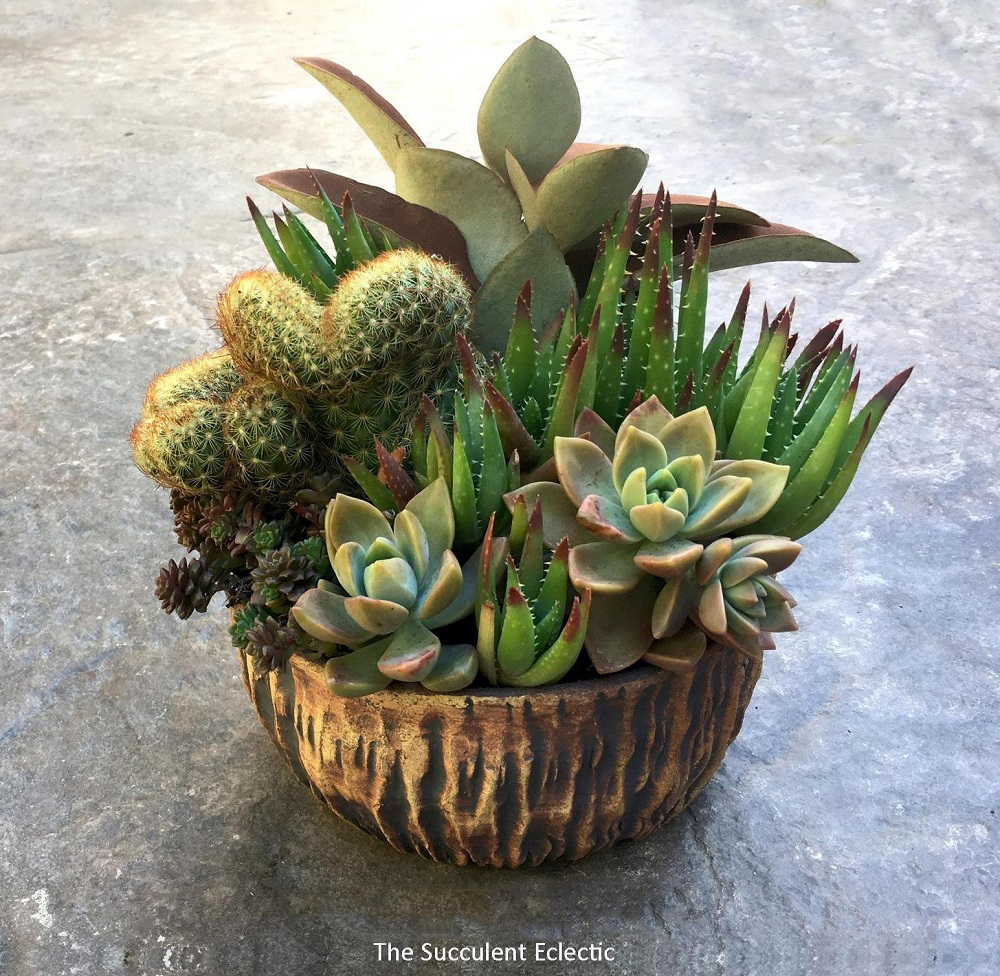
I love beautiful pottery like this pot by Susan Aach. And I love planting lots of different succulents all mixed together. But some succulents go dormant in summer and some in winter. And when a succulent is actively growing, it needs water, but when it’s dormant, it should remain dry. Eek! Does that mean you can only plant winter-dormant succulents with others dormant in winter, and summer-dormant plants with others? But, what about those that don’t “decide” to go dormant this season — what then?
The good news is, you don’t need to worry — the succulents have got it all figured out! When you close-plant succulents like this, you take advantage of the plants’ adaptations to scarce resources. The same way succulents maximize but don’t outgrow the available resources like water, nutrients and space, means that active, awake plants will take up any water not used by nearby dormant plants. This is actually an advantage to mixed succulent plantings that are crowded — there are a lot of roots in the same soil, making use of the available water. If instead, this bowl only had three, small plants with lots of extra soil and space between them, it would be harder for any individual plant to take up all the water left behind by a dormant neighbor. Crowded containers make succulent care in summer easier!
To Groom or Not to Groom?
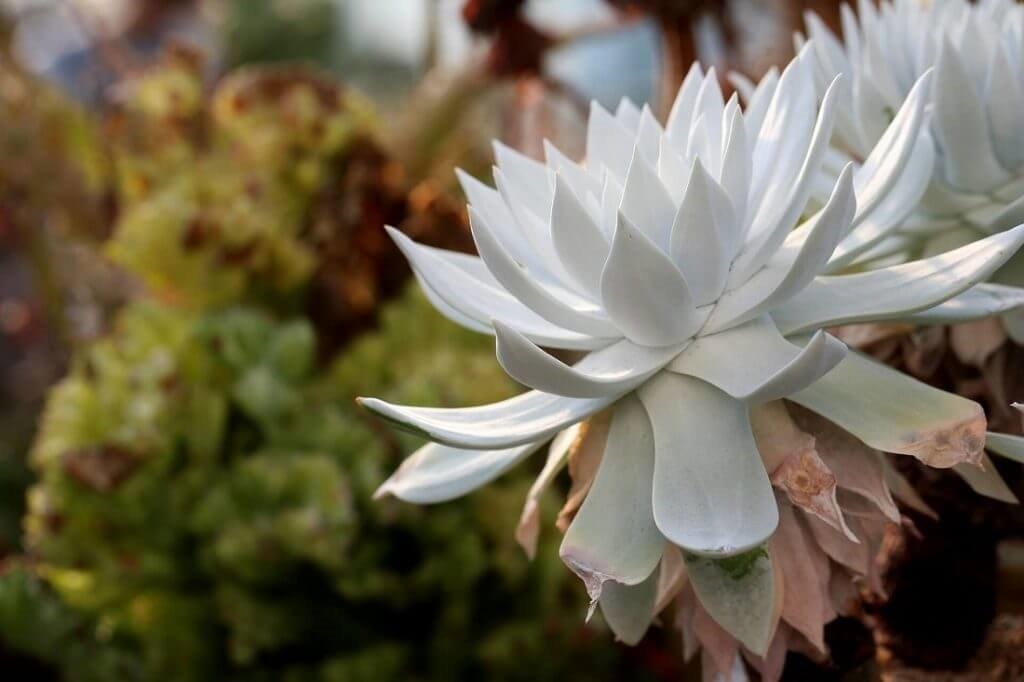
We’re always on the alert for signs our succulents need help. But some dried, dead leaves are supposed to happen. Echeveria and some other varieties routinely produce fresh, new growth from the center of each rosette, and they slough off old, dried leaves at the base of the rosette. This is a natural occurrence, much like how we slough off dried, dead skin cells. These leaves can simply be removed as you groom your plants to keep them tidy.
However, be aware that those dried, dead leaves serve a purpose. When left in place, those leaves shade the plant’s stem in summer, preventing sunburn and keeping the stem cool so it doesn’t lose too much water through transpiration. In the winter, those leaves insulate the stem, keeping it warmer. If you remove the leaves to suit your preference for a tidier looking plant, be prepared to provide the care necessary to make up for the protection you remove. Succulent care in summer may include leaving your plants in their natural, somewhat unkempt condition.
Summer Pests and Succulents
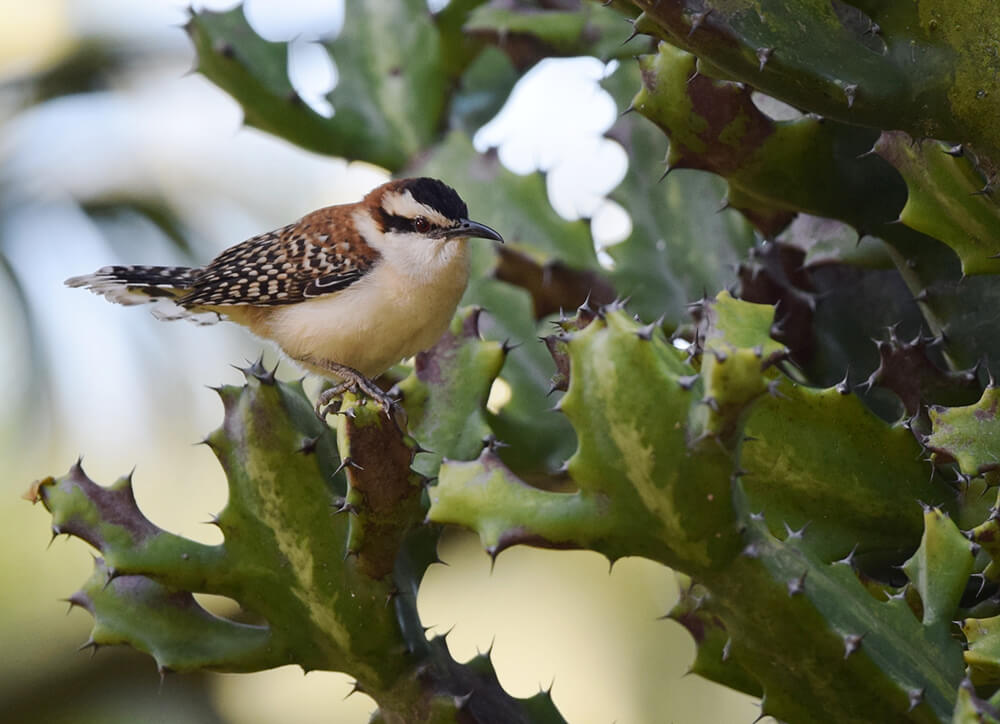
Summer’s heat and drought are a challenge for animals as well as plants. And an important way that mammals, birds and insects combat summer’s heat is by feasting on the moisture-rich, tender flesh of your beloved succulents. While worm castings are the ideal way to prevent damage from mealybugs and other insects, they have no effect on mammals or birds. Succulent care in summer requires that you protect your plants from desperate birds and mammals, but basic kindness requires that we do so with compassion.
While you can use netting, I worry about animals or birds getting caught and injured in the netting. My first line of defense is to provide a few sanctioned sources of water for the animals and birds. If they aren’t desperate for water, it’s so much easier to protect the plants. Between various water features and a couple of active cats, I have no more trouble with squirrels or birds in summer.
For those that need further assistance, I have heard great results from using a realistic-looking rubber snake. Set it on the ground, near the plants you want to protect to keep the birds and mammals away. It’s probably best to move it around every few days, to keep it realistic and effective.
Conserve Water and Repel Pests with Top Dressing
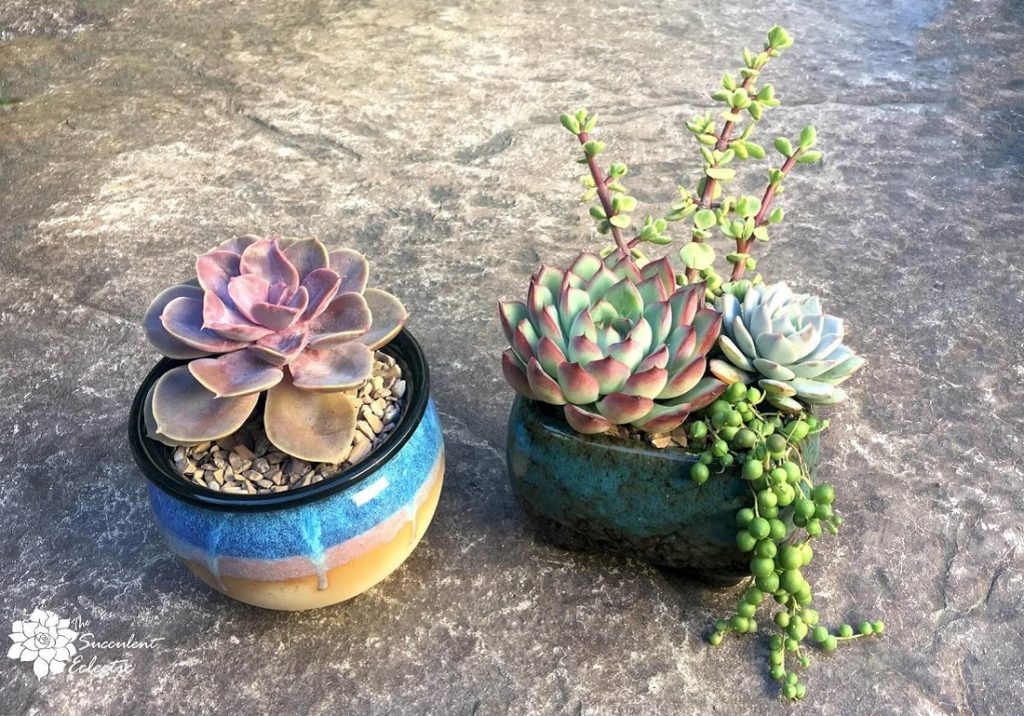
There are many values to using inorganic top pressing for succulents in any season. But there are three chief benefits that make it an important part of succulent care in summer.
Inorganic top dressing slows the evaporation of the soil’s water, ensuring it goes to the roots, where your plant needs it. Top dressing also insulates the soil, keeping it cooler in summer and warmer in the winter. This protects the roots from extreme shifts in temperature. It is also an important defense against insects that feed on the moisture stored in your succulents’ leaves. These insects cannot lay their eggs on the inorganic top dressing, and the hatchlings cannot burrow out from under the pebbles to reach the surface of the soil. Top dressing interrupts the life cycle of the pests. Make inorganic top dressing part of your summer care for succulents.
Adding New Succulents in Summer
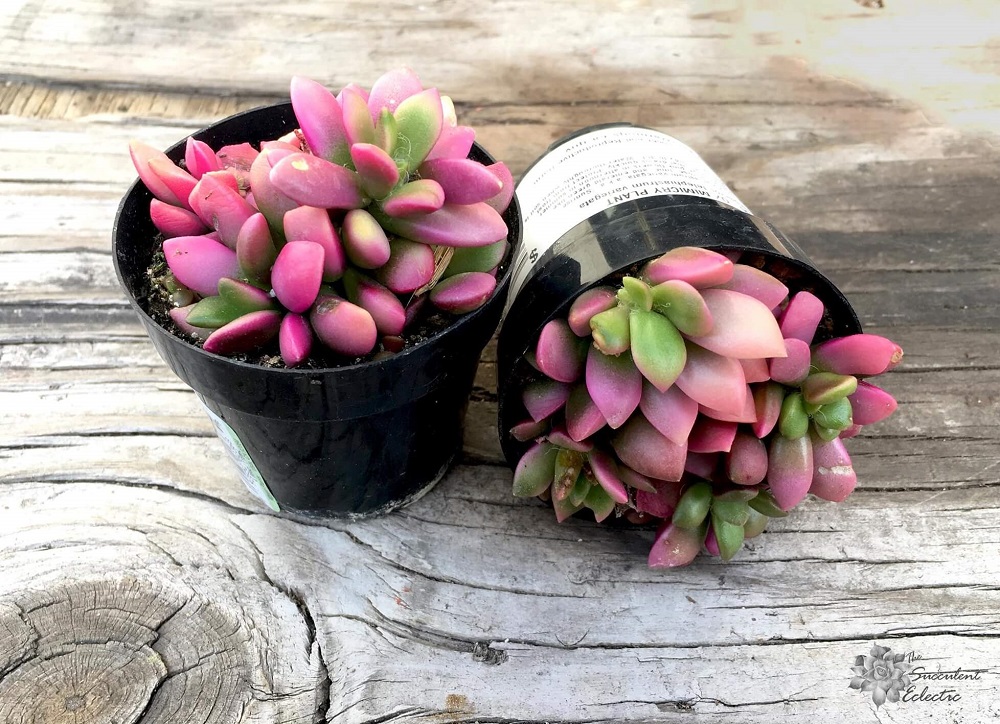
Summer is indeed challenging, but it’s no reason to stop buying new succulents! 🙂 Just be aware of a couple of issues:
First, those black plastic nursery pots really heat up in the summer sunshine. The black plastic soaks up the heat and transmits it to the soil and roots of the plant. (Metal containers in full sun are even worse and can lead to cooked roots.) An important part of succulent care in summer is evaluating the containers your succulents are in so they do not bake in the season’s heat. Transplant new succulents into good succulent soil and the pot you want them to live in.
Next, pay attention to the succulents’ recent growing conditions. If you buy your plants from a nursery, look around and make note of the conditions where it is growing. Is it in full sun? Is it shaded a good bit? Is there shade cloth above the plant? These are the conditions that made the plant into something you chose to add to your collection. Make sure you put it into similar conditions in your garden. If you ordered the plant online, remember that it was shut up in a dark box for a few days. Allow it to acclimate slowly to the lighting in the spot where you want it to grow.
Now that you know how to provide summer care for succulents, I hope you and your family are prepared to have a great summer! The world seems largely upside down just now, so stay safe, stay sane, and plant succulents!

P.S. For more succulent care information, please subscribe to The Succulent Eclectic! I’ll send you my FREE e-course 7 Steps to Succulent Success!
P.P.S. Why not join my Facebook Group for succulent lovers? We talk about succulent care, propagation, succulent identification, and design. It’s a warm and welcoming group that would love to meet you!
